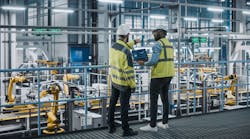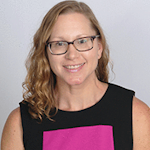A Control Design reader writes: Technology suppliers are continually offering automation components that are easier to integrate and install, and many market these plug-and-play products as a solution to the growing worker shortage. Who in the industry is asking for these types of solutions—machine builders, system integrators or end users? All of the above? Is this trend industry-led or industry-specific?
As an automation engineer for a machine builder, we do have trouble finding young talent, but I worry that the democratization of automation technology might still put me out of a job someday. I think the idea is to use our engineering talent for more important work, but, as a manager, I would still be uncomfortable with less-qualified people working on our machines. What am I missing here? Should I be thinking about this differently or thinking about managing our engineering talent differently?
Answers
No longer the domain of a few
The evolution of technology in the industrial-automation space is driven by both end-user communities and standards-development organizations. And, in many cases, direct customer input drives product developments and product enhancements.
We’ve all witnessed how consumer products and technologies have evolved over the past few decades as the internet, cloud and networking became an important part of the consumer experience. These new networks democratize access to information about products and their many possible uses. They have provided us with many new ways to educate those who are interested in a product, service or skill.
All it takes is a computer and internet access, and users can now choose between open or proprietary systems, industrial or even hobby electronic platforms to automate projects at home or work. Great examples include the Raspberry Pi or Arduino control systems, the Blender open-source animation software package, or YouTube with many user-created videos of tutorials and projects.
Industrial automation is no longer the domain of a few, but the potential playground for many. And technology with software, simulation and hobby-automation electronics provides excellent learning tools if used correctly.
A digital transition is taking place in industrial automation, allowing remote voices to be part of the conversation in developing new standards. Ensuring that industrial-automation platforms adhere to a specification that is replicable and offers longevity for an industry that lasts decades longer than most consumer products. The user experience (UX) is one of simplicity, and its implementation is important to ensuring the technology, when deployed, is commissioned efficiently and easy to maintain.
Working with standards development organizations (SDOs), the International Electrotechnical Committee (IEC), national standards organizations and a host of end-user groups, agreed-upon standards are developed to enhance and improve on the foundations of existing standards. All it takes is time, willing and competent subject matter experts and sufficient funding to develop novel methods and solutions for our industry.
A lot does happen in the standards world, where entirely new standards can take as long as a decade to be published at the international level, or just a few years to be deployed at a national or regional level.
Customers in our industry expect the same simplicity and easy-to-deploy capabilities we have come to experience as owners of consumer electronics. And our projects are more networked, requiring more cybersecurity and machine safety to protect the valuable systems we build.
These skills do not get trained and developed at school or at college; they happen in the workplace, so it is our responsibility to take on the challenge and invest in the future workforce with dedicated in-company activities.
The world is getting more automated, and we do not have enough engineers entering the workforce, so we need to empower managers and leaders to train the next generation. The more seasoned engineers should be mentors and guides for the students in high school and college to the workplace of today. Getting involved with local FIRST (For Inspiration and Recognition of Science and Technology), LEGO Mindstorms and BEST (Boosting Engineering Science & Technology) Robotics activities can also provide you with splendid opportunities to nurture talent at the high-school and college level.
Students know little about the exciting automation programs and possibilities in our field. And yet they practice the same techniques in time and project management, problem solving and team building, and they develop engineering skills in the competitions they participate in every year.
Reach out to a local high school, trade school or college and see if their career, science or physics educators are looking for local support from industry. Establish partnerships with the educators, and, over time, you will be involved with many students in the science, technology, engineering and mathematics (STEM) fields as they develop from young students to talented engineers, technicians and problem-solvers.
For example, every year some of our engineers take a few hours off during Engineers Week to share technical and science applications with sixth graders. It is a great way to inspire the next generation of engineers. Other great ways to uncover and develop local talent include hosting open-house events or providing job-shadow and internship opportunities to high-school and college students, coordinated with teachers and professors.
In Harrisburg, Pennsylvania, we saw a need for local skills in the mechatronics field—a mechanical, electrical, automation and software combination—so we hire high-school graduates into a multi-year apprentice program to attend both on-site, in-factory training with real machinery and local associate-degree training at a local community college. And our apprentices earn a salary on day one (Figure 1).
Youth is a consumer of real and virtual automation. Would you and your company consider building a flight or driving simulator, or creating a piece of automation that could be safely used and demonstrated in a classroom environment?
Technology may actually reduce the time planning, designing, testing and building new machines, raising efficiency and reducing turnaround time on automation projects. This means there is a lot more work ahead of us in our field.
We have invested years in our own careers. We can now pay it forward by investing in new talent and the next generation for our industry.
Arnold Offner / strategic manager / Phoenix Contact
IT/OT convergence provides more for less
Although the worker shortage is a spoke in the wheel of product development for technology providers, it only makes up a percentage of that wheel. I think we can all agree that "better" is the driving factor for all innovation. Although iPhones seem to be getting harder to use, I would say the bulk of products trend the opposite way. If you are curious to know the types of users/industries that want more for less, I would challenge you to find a company or industry that doesn't want more for less. This is why homo sapiens uniquely developed tools and was able to differentiate itself.
That being said, what industries are benefiting the most from these technologies? Manufacturing by nature involves a lot of repetitive and labor-intensive work, and manufacturing has also been heavily affected by worker shortages. What started as methods to automate assembly lines has now trickled into methods to automate business decisions. This is where the information-technology (IT)/operational-technology (OT) convergence and digital transformation talk comes into play.
In order to make better business decisions, IT systems need to talk to OT systems, and the professionals from those realms must now speak a common language. Tools from software development are far beyond the capabilities of our current OT tools, so it's been only a matter of time before these tools started to converge as the two worlds did the same. From this convergence came new methods for scalability, ease of use and interoperability.
Tyrone Visser / business development manager, Linux + IIoT—North America / Wago
Plug-and-play
The root cause is a major issue among end users. Manufacturers and process operators are experiencing the “great crew change.” They are losing highly knowledgeable, experienced boomers to retirement and struggling to transfer valuable know-how to newcomers. At the same time, they have found that millennials and Gen Z are less interested than prior generations in pursuing careers in the industry; hence, the worker shortage has developed.
This is the case in the energy and chemical processing industries, as well as many manufacturing industries. While plug-and-play solutions do address the worker shortage, there are other drivers, as well.
Companies in these industries are pursuing digital transformations that are necessary to not only survive, but also thrive, in a post-COVID business ecosystem that demands agility and resilience. Plug-and-play solutions enable those qualities by reducing costs and streamlining project scheduling.
Incidentally, one of the benefits of digital transformation is ultimately making workplaces safer, more secure and more desirable to prospective employees. As part of environmental, social and governance (ESG) initiatives, companies in these industries are pursuing broad programs to make them attractive to employees.
What is the solution for people who are concerned about job security? Upskilling. To tackle the worker shortage and new business environment, companies are doing much more than deploying plug-and-play products. As part of their digital transformations, they are pursuing autonomous operations using artificial intelligence, mobile robots and a host of other technologies. Those will require people with new skillsets, many of which are only beginning to emerge.
Kevin Finnan / digital transformation consultant / Yokogawa of America
Scalability
This trend is coming from many angles. Technology suppliers, system integrators and end users all have different motivations for the trend, but increasingly the unifying goal is scalability.
For a system integrator, the value-add to a project is the confluence of the industry-domain expertise with the product technology know-how. Whether selling services hourly or per deliverable, the key to the ability to scale the business is to use automation to assist in getting the expertise delivered on projects more quickly.
Technology suppliers typically find themselves in flux between scaling up their existing markets and entering new ones. This situation necessitates that less of an individual’s time be spent on each unique opportunity. Plug-and-play and automation tools, where possible, promise to streamline new opportunity engagements while also earning the praise of users who are liberated from repeated tasks.
With end users, worker shortages certainly can be a factor, but perhaps more than that are the challenges of handling the knowledge transfer from the older generation headed toward retirement onto the next generation replacing them. By and large the newer generation of workers expects there to be a great deal of interoperability and plug-and-play capabilities inherent within the technologies they use. As they are being asked to become proficient in an ever-increasing number of technologies and platforms, automation of certain aspects is an inevitable solution to help take some responsibilities off their plates whilst others are being piled on.
Finally, in not so many words, everyone is busy and only getting busier. Automation and plug–and-play are the natural solutions we reach for when attempting to regain control and to simplify what was once complex.
Understandably, some automation engineers might have concerns about the democratization of automation technology and the possible impact this situation can have on their jobs. Below are several aspects to consider that can allow them to make the most out of this changing and possibly challenging environment:
• Adapt and innovate: Look for opportunities to adapt and innovate to the evolving environment. Explore new technologies, techniques and applications that complement or even enhance existing automation systems. Actively seek out ways to improve and optimize processes that will allow engineers to contribute to their organizations more effectively and therefore to remain relevant in the field.
• Collaborate and mentor: Instead of relying on fewer qualified individuals to work on machines, consider adopting a collaborative approach. Experienced engineers can mentor and guide less-experienced team members to promote and advance knowledge transfer and skill development. As a result, automation projects can be effectively executed to maintain quality standards.
• Engage in continuous learning: Engaging in continuous learning and professional development is crucial for automation engineers to stay updated with the latest technology and advancements in the field and to maintain a competitive edge. An investment in continued training and knowledge acquisition pays off and means engineers can handle the increasing complexity of projects.
• Focus on specialization: Focusing on specialization in areas that require in-depth expertise and domain knowledge makes an engineer more well-rounded and valuable. By developing these specializations, engineers bring more value to the job, thus differentiating themselves within an organization.
• Embrace the shift: Take a positive approach to this reality by embracing the shift and viewing it as an opportunity. Use your time and expertise to focus on more complex and critical tasks that require creativity, problem-solving and judgment. Leverage your talent and experience to significantly contribute to success.
Experience and knowledge are irreplaceable. Look at change as a great chance to improve and evolve as an engineer, which is positive, healthy and exciting. With this attitude, automation engineers can approach this new landscape to help position themselves as valuable assets within any organization.
Jotham Kildea / solutions sales engineering supervisor / Iconics
Standardization of communication protocols
The transition to automation in manufacturing processes has really exploded in the past 20 years. The onset of COVID-19, which only exacerbated the growing worker shortage, exponentially pushed businesses to make the move toward automation. This transition in the industry is all-encompassing, including machine builders, systems integrators, original equipment manufacturers (OEMs) and even small shops.
To stay competitive with low-cost labor markets, while still meeting customer quality demands, the only logical solution is automation. This also creates a need in the automation-component manufacturing business to standardize communications between components. The standardization of communication protocols has been instrumental in the expansion of automated processes.
Years ago, if an engineer started with an Omron PLC, every component down the line had to be Omron, as well. You can mix and match components from different manufacturers down the line, utilizing the best products from the best manufacturers together in harmony. We now even see products that can enable communication across devices through multiple protocols simultaneously and convert them to a unified protocol.
Whenever there is a major shift in industry, there will be jobs that become obsolete. This also creates more higher-quality jobs that are more fulfilling to workers in terms of quality of pay, benefits and overall job satisfaction. For example, when Microsoft released Excel, experts said that would be the end of the accountant. Instead, it was the complete opposite.
Accounting still ranks as one of the most highly sought-after professions. The more processes automate, the greater the need for automation engineers, especially for machine builders and systems integrators. Being a machine builder is a pretty good career to have going into the future.
Eric Halvorson / partnership marketing manager II—strategic programs / DigiKey
Industry-oriented and industry-specific
As a supplier of automation products, we are constantly developing technological advances to provide more information that can assist in manufacturing. Not only are these devices easier to install and integrate, but they can also help save time and energy by providing process data. For this reason, they are in demand by everyone involved in the decision-making process, including machine builders, system integrators, contact packaging groups and end users.
Machine builders and system integrators utilize these solutions to streamline processes, reduce time for new developments and improve efficiency in building and integrating automation systems. End users and consumer-packaged-goods (CPG) manufacturers are also expressing interest in plug-and-play products to address labor shortages and enhance their operational capabilities.
The ability to offer easier-to-integrate automation components is both industry-oriented and industry-specific. Component integration is industry-oriented in the sense that as an automation suppler we meet the needs and demands of the market, which includes the desire for more accessible and user-friendly automation solutions. Simultaneously, it is industry-specific because automation technologies are widely deployed in various sectors at different stages and with specific requirements and needs.
I fully understand your concerns as an automation engineer and manager. Will this have an impact on staff costing or job security? However, it is important to understand that the goal of Industry 4.0 and automation in general is never to replace skilled engineers, quite the opposite. Using these technologies can only help expand your team’s capabilities and free up their time for more complex work.
Advances in automation technology allow engineers to focus on higher-level designs, drive innovation, find better troubleshooting solutions and develop the next level of value-added activities that require their expertise.
Instead of viewing the democratization of automation as a threat, use this opportunity to apply your engineering talents to more meaningful endeavors. With the ability to use plug-and-play components, your team can spend less time on mundane tasks and instead focus their skills on more innovative projects. This will lead to more productivity, creativity and overall growth for your company.
Some ideas for effectively managing your engineering talent might include the following approaches:
1. Upskill: Encourage your team members to expand their skills in areas that complement automation technologies, such as data analytics, machine learning or advanced control systems. This way, they can stay ahead of the competition and contribute to the development of cutting-edge solutions.
2. Collaboration: Create a collaborative environment where engineers can work closely with automation technologies, combining their expertise with the capabilities of plug-and-play components. This collaboration will result in more efficient and powerful automation systems.
3. Continuous learning: Emphasize the importance of ongoing learning and professional development. Encourage your engineers to keep up with trends and advances in automation technology and attend workshops, conferences and training programs.
4. Specialization: Identify areas in your team where expertise is not as strong, and encourage engineers to specialize in those areas. This will ensure that your team has the necessary skills and knowledge to tackle complex projects and gain a competitive advantage.
By embracing this rapidly changing automation landscape and redefining the roles of your engineering talent, you can manage your company for long-term success and continually adapt to the evolving needs of the industry.
Perry Hudson / market manager, packaging / Pepperl+Fuchs
Integration and communication
This trend of plug-and-play automation products might be cast more precisely as natural product evolution. As time marches along, the forces of competition inevitably lead to products and processes that are easier to implement and use.
The goal of easing the integration of devices into control systems is to take away the busy work of controls integration. Hopefully, engineers’ time is not consumed by mundane tasks of trying to get Box A to connect to Box B, which will in turn pass data to a device. The engineer should be free to concentrate on building an elegant, robust and effective control design. The aim should be to allow humans to do what they do best, apply creativity to technical problems, and not have to worry about the repetitive work of connecting a series of devices together and making them communicate.
Even with plug-and-play products, you will always need highly skilled engineers to understand the machine and choose the best components, whether they be plug-and-play components or a more specialized combination of products, all depending on the needs of the machine, the customers and the market competition.
Continue focusing on hiring top-notch engineers. If plug-and-play components allow some portions of the job to become streamlined enough that they do not require advanced engineers, you may be able to fill some roles with technicians. In any case, you will always need some top engineering talent so that your machines maintain an edge in the marketplace, whether that edge is features, pricing or both. If you don’t, competitors will step in and do it.
Jacob Paso / motion products development manager / Delta Computer Systems
IO-Link
The worker shortage is not specific to any one industry or customer type, but we’ve seen increased demand for plug-and-play products in fast-growing segments like semiconductor and e-commerce/warehouse automation. One way our customers simplify both installation and operation of industrial components is through IO-Link, where, once a sensor is configured for a particular application, the teach button can be locked remotely to avoid tampering by an operator who may not be trained to adjust the sensor setpoints.
As more components connect to the programmable logic controller (PLC), the work to manually wire or configure via dual in-line package (DIP) switch is greatly reduced, as well, which can be helpful to customers facing a shortage of controls engineers. Even more complex devices offer guided workflows and wizards to aid in commissioning and reduce the burden on the customer to have deep domain expertise on every device.
Kate Sokolnicki / business manager—in-cabinet infrastructure, safety, sensing and industrial components / Rockwell Automation






